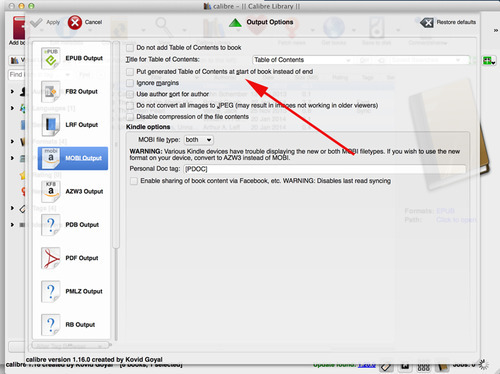Guest post by
Wil Forbis
Lately, I’ve been mired in the more technical aspects of eBook production. One area of study has been the specifics of how Tables of Contents are presented by various eBook reading devices and software. Details about this are scattered about the web and I thought it would be useful to capture the relevant points in one blog post.
The first curious lesson to learn is that eBooks can have two types of TOCs. One type is the
content TOC (sometimes called the HTML TOC) which usually appears as a series of links for each chapter at the beginning or end of a book. The second type is the
metadata TOC (sometimes calls NCX TOC) which usually appears in a menu of some sort on the eBook reading device or software. The Go To menu on the Kindle is an example of a metadata TOC.
That’s all we really need to know for a cursory understanding of the two TOC types but more information can be found
at this FAQ node on the web site for the Calibre software.
Next, be aware that the generation of the metadata TOC is automatic in most eBook production tools. That leads us to two questions: How do I create a content TOC? And should I do so?
The first question has many answers, of course, depending on how you are generating your eBook. Below, I discuss and screenshot the tools I’m familiar with (with one exception.) I’m using the Mac versions of these programs but you should be able to find something equivalent in the PC version if it exists.
- Scrivener (ver 2.5): On the Compile screen>Layout Tab, click the “Generate HTML Table of Contents” checkbox.

- Calibre (ver 1.12) : On the Output Options screen launched from the Preferences>Change Calibre Behavior menu item, there are various checkboxes related to TOC generation broken down by output format (e.g. MOBI, AZW3 etc.) By default, Calibre adds a TOC to the end of the book; the relevant checkboxes change this behavior. (A review of the Calibre help text on TOCs may be a good idea here.)

- HTML: If you’re an ambitious code monkey, you can build your TOC into an ePub file. You can then convert that file to a MOBI by using Calibre or the Kindle Previewer. This tutorial should get you going: Build a Digital Book with EPUB.
- Word: While I haven't tested it, this blog post provides instruction on using MS Word to add a content TOC.
Now for the second question: should you add a content TOC? If the metadata TOC could be counted on to be available in every situation it would be easy to answer no. Sadly, this is not the case. I came across two instances with MOBI files where the metadata TOC was not enough: the Kindle reader app running on the iPad and an older e-ink Kindle (4+ years) I have lying about. In these cases, not including a content TOC doomed the book's reader to have no ability to jump to a specific chapter.
It's something of an odd twist that for these cases (e.g. the older Kindle and the iPad Kindle app) the content TOC, not the NCX TOC, is used to populate the Table of Contents link on the Go To Menu. You can include the content TOC for these cases but you can hide it in the back of the book. There are several ways to do this but the easiest is by using the Calibre software. By default, Calibre generates MOBI files with TOCs at the end. If you find it’s placing them at the front you may need to uncheck the relevant setting in the Output Options screen shown above.
EPubs can work fine with just a meta TOC. You are of course free to add a content TOC if you see fit.
Having said all this, it's debatable whether you need a TOC at all. Fiction books often avoid them, especially if using uninformative chapters titles like "Chapter One, Chapter Two" etc. However, there are
reports of users receiving "warnings" from Amazon that their book has no TOC. Keep that in mind when deciding.

